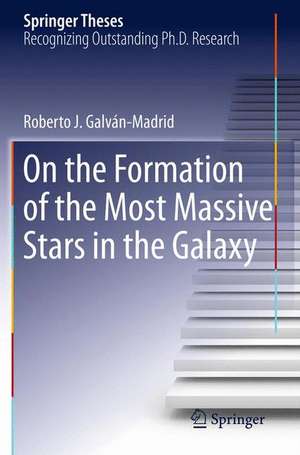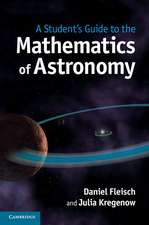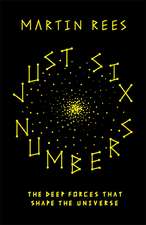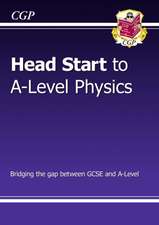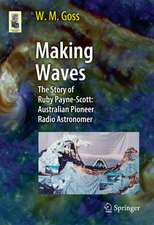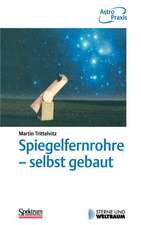On the Formation of the Most Massive Stars in the Galaxy: Springer Theses
Autor Roberto J. Galván-Madriden Limba Engleză Paperback – 12 iun 2012
This thesis presents results of Submillimeter Array (SMA) and Very Large Array (VLA) studies of massive star formation regions in the early stages of ionization, as well as an analysis of numerical simulations of the evolution of these young HII regions. The results favor a picture in which very massive stars form in accretion flows that are partially ionized and that keep accreting material from their environment.
Din seria Springer Theses
- 18%
 Preț: 997.88 lei
Preț: 997.88 lei -
 Preț: 389.88 lei
Preț: 389.88 lei - 15%
 Preț: 646.94 lei
Preț: 646.94 lei - 18%
 Preț: 943.43 lei
Preț: 943.43 lei -
 Preț: 399.29 lei
Preț: 399.29 lei - 18%
 Preț: 944.99 lei
Preț: 944.99 lei - 15%
 Preț: 636.80 lei
Preț: 636.80 lei - 18%
 Preț: 941.05 lei
Preț: 941.05 lei - 15%
 Preț: 643.16 lei
Preț: 643.16 lei - 15%
 Preț: 642.68 lei
Preț: 642.68 lei - 18%
 Preț: 1103.62 lei
Preț: 1103.62 lei - 20%
 Preț: 558.83 lei
Preț: 558.83 lei - 18%
 Preț: 1112.30 lei
Preț: 1112.30 lei - 18%
 Preț: 944.19 lei
Preț: 944.19 lei - 18%
 Preț: 1109.92 lei
Preț: 1109.92 lei - 18%
 Preț: 1217.27 lei
Preț: 1217.27 lei - 15%
 Preț: 640.06 lei
Preț: 640.06 lei - 15%
 Preț: 636.45 lei
Preț: 636.45 lei - 15%
 Preț: 640.06 lei
Preț: 640.06 lei - 15%
 Preț: 640.88 lei
Preț: 640.88 lei -
 Preț: 389.70 lei
Preț: 389.70 lei - 20%
 Preț: 563.91 lei
Preț: 563.91 lei -
 Preț: 393.35 lei
Preț: 393.35 lei - 15%
 Preț: 637.93 lei
Preț: 637.93 lei - 15%
 Preț: 641.85 lei
Preț: 641.85 lei - 18%
 Preț: 1225.94 lei
Preț: 1225.94 lei - 20%
 Preț: 551.36 lei
Preț: 551.36 lei - 18%
 Preț: 1229.10 lei
Preț: 1229.10 lei - 15%
 Preț: 639.25 lei
Preț: 639.25 lei - 18%
 Preț: 999.45 lei
Preț: 999.45 lei - 15%
 Preț: 640.06 lei
Preț: 640.06 lei - 18%
 Preț: 1220.45 lei
Preț: 1220.45 lei - 18%
 Preț: 1116.26 lei
Preț: 1116.26 lei - 18%
 Preț: 1110.72 lei
Preț: 1110.72 lei - 18%
 Preț: 1000.87 lei
Preț: 1000.87 lei - 18%
 Preț: 891.17 lei
Preț: 891.17 lei - 15%
 Preț: 640.06 lei
Preț: 640.06 lei - 5%
 Preț: 1154.07 lei
Preț: 1154.07 lei - 15%
 Preț: 635.96 lei
Preț: 635.96 lei - 15%
 Preț: 640.88 lei
Preț: 640.88 lei -
 Preț: 387.20 lei
Preț: 387.20 lei - 18%
 Preț: 1109.92 lei
Preț: 1109.92 lei -
 Preț: 385.25 lei
Preț: 385.25 lei -
 Preț: 385.25 lei
Preț: 385.25 lei - 18%
 Preț: 1112.30 lei
Preț: 1112.30 lei - 18%
 Preț: 999.45 lei
Preț: 999.45 lei -
 Preț: 386.99 lei
Preț: 386.99 lei - 15%
 Preț: 637.13 lei
Preț: 637.13 lei - 20%
 Preț: 554.21 lei
Preț: 554.21 lei - 20%
 Preț: 555.59 lei
Preț: 555.59 lei
Preț: 379.09 lei
Nou
Puncte Express: 569
Preț estimativ în valută:
72.56€ • 78.84$ • 60.99£
72.56€ • 78.84$ • 60.99£
Carte tipărită la comandă
Livrare economică 22 aprilie-06 mai
Preluare comenzi: 021 569.72.76
Specificații
ISBN-13: 9781461433071
ISBN-10: 146143307X
Pagini: 174
Ilustrații: XIII, 122 p. 49 illus., 23 illus. in color.
Dimensiuni: 155 x 235 x 10 mm
Greutate: 0.2 kg
Ediția:2012
Editura: Springer
Colecția Springer
Seria Springer Theses
Locul publicării:New York, NY, United States
ISBN-10: 146143307X
Pagini: 174
Ilustrații: XIII, 122 p. 49 illus., 23 illus. in color.
Dimensiuni: 155 x 235 x 10 mm
Greutate: 0.2 kg
Ediția:2012
Editura: Springer
Colecția Springer
Seria Springer Theses
Locul publicării:New York, NY, United States
Public țintă
ResearchCuprins
Foreword by Prof. Luis F. Rodriguez (CRyA-UNAM) and Dr. Qizhou Zhang (Harvard-Smithsonian Center for Astrophysics).-Chapter 1: Introduction to the Scientific Problem.- Chapter 2: A MSFR at the Onset of Ionization: W33A.- Chapter 3: A MSFR with young UC and HC HII Regions: G20.08N.- Chapter 4: Time Variability of HII Regions: A Signature of Accretion?.- Chapter 5: Time Variability of HII Regions in Numerical Simulations of MSFR.- Chapter 6: Conclusions.- Bibliography.- Appendix I: Radio and (Sub)millimeter Interferometers.- Appendix II: Molecular-line Emission.- Appendix III: Ionized-Gas Emission.- Index.
Notă biografică
Dr. Roberto Galván-Madrid was born in 1982 in Chetumal, Mexico, where he had his basic and high-school education. He obtained a bachelor degree in Physics from the Autonomous University of Nuevo Leon (UANL) in 2005, and a Masters degree in Astronomy from the National Autonomous University of Mexico (UNAM) in 2007.
The thesis published here is a compilation of the work presented by RGM in August 2011 to obtain his Ph.D. degree in Astronomy from UNAM, under the supervision of Prof. Luis F. Rodríguez. During most of his thesis work, RGM was based at the Harvard-Smithsonian Center for Astrophysics (CfA), working as a Pre-doctoral fellow of the Submillimeter Array Project (SMA) under the supervision of Dr. Qizhou Zhang and Dr. Paul T. P. Ho.
RGM's scientific interests are the processes of star formation, with emphasis on the formation of high-mass stars and clusters. Starting September 2011, RGM works as a postdoctoral fellow for the European Organization for Astronomical Research in the Southern Hemisphere (ESO).
The thesis published here is a compilation of the work presented by RGM in August 2011 to obtain his Ph.D. degree in Astronomy from UNAM, under the supervision of Prof. Luis F. Rodríguez. During most of his thesis work, RGM was based at the Harvard-Smithsonian Center for Astrophysics (CfA), working as a Pre-doctoral fellow of the Submillimeter Array Project (SMA) under the supervision of Dr. Qizhou Zhang and Dr. Paul T. P. Ho.
RGM's scientific interests are the processes of star formation, with emphasis on the formation of high-mass stars and clusters. Starting September 2011, RGM works as a postdoctoral fellow for the European Organization for Astronomical Research in the Southern Hemisphere (ESO).
Textul de pe ultima copertă
The most massive stars in the galaxy - those with more than 15 to 20 solar masses - are lilkely to ionize their surroundings before they reach their final mass. How can they accrete in spite of the presence of over-pressurized gas?
This thesis presents results of Submillimeter Array (SMA) and Very Large Array (VLA) studies of massive star formation regions in the early stages of ionization, as well as an analysis of numerical simulations of the evolution of these young HII regions. The results favor a picture in which very massive stars form in accretion flows that are partially ionized and that keep accreting material from their environment.
The American Astronomical Society selected Roberto Galvan-Madrid as a prize winner for The Rodger Doxsey Travel Prize in 2010.
This thesis presents results of Submillimeter Array (SMA) and Very Large Array (VLA) studies of massive star formation regions in the early stages of ionization, as well as an analysis of numerical simulations of the evolution of these young HII regions. The results favor a picture in which very massive stars form in accretion flows that are partially ionized and that keep accreting material from their environment.
The American Astronomical Society selected Roberto Galvan-Madrid as a prize winner for The Rodger Doxsey Travel Prize in 2010.
Caracteristici
Presents results of Submillimeter Array (SMA) and Very Large Array (VLA) studies of massive-star formation regions in the early stages of ionization Author has received the 2010 Doxey Prize, given out yearly by the American Astronomical Society Includes supplementary material: sn.pub/extras
